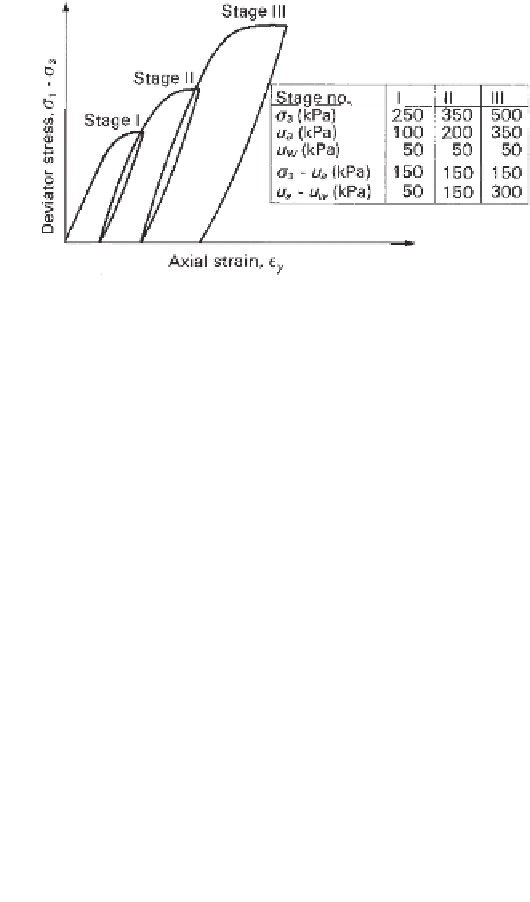Environmental Engineering Reference
In-Depth Information
rate at which the top and bottom halves of the direct shear
box are displaced:
of half the specimen height
h
. The direct shear test has the
advantage that a thin soil specimen can significantly reduce
testing times for shear strength.
d
h
t
f
d
h
=
(11.35)
11.9.4 Multistage Testing
Multistage testing can be performed using triaxial or direct
shear equipment. Benefit is derived from being able to alter
the stress path during the testing of a single soil specimen.
Multistage testing is used to maximize the amount of shear
strength information that can be obtained from one speci-
men. It also assists in eliminating the effect of soil variability
on the test results. Multistage triaxial testing of saturated
soils usually consists of using several effective confining
pressures
σ
3
−
where:
d
=
horizontal shear displacement rate for a direct shear
test, and
d
h
=
horizontal displacement of the soil specimen at
failure.
The horizontal displacement at failure,
d
h
, depends on
the soil type and the soil stress history. An estimate of the
horizontal displacement at failure is required in order to
compute the horizontal shear displacement rate
d
h
.
The theoretical estimation for the time to failure
t
f
used in
triaxial testing (i.e., Eq. 11.34) is also applicable to drained
direct shear tests (Eq. 11.35). The excess pore pressures devel-
oped during a drained direct shear test are also dissipated one
dimensionally in the vertical direction. Pore-water is com-
monly drained out of the bottom of the specimen through
the high-air-entry disk. The impedance factor for direct shear
tests can be computed using Eq. 11.33 (Fig. 11.88). The time
to failure
t
f
for direct shear tests can be computed using
Eq. 11.34 (Fig. 11.90). Figure 11.90 is a plot of the time
to failure for various impedance factors and coefficients of
consolidation. The plot is generated for a specimen height
of 12.7 mm.
The horizontal shear displacement rate
d
h
can be com-
puted from Eq. 11.35 using estimated values of
d
h
and
t
f
.
Typical horizontal shear displacement rates that have been
used in direct shear testing on unsaturated soils are listed in
Table 11.9.
A comparison of Figs. 11.89 and 11.90 reveals that the time
required to fail the soil specimen is substantially reduced by
using a thinner soil specimen. This can be observed from
Eq. 11.34 where the time to failure is a function of the square
u
w
when testing one soil specimen. A Mohr-
Coulomb failure envelope can be drawn tangent to Mohr
circles corresponding to failure at the various effective con-
fining pressures.
Multistage triaxial testing has been used in conjunction
with a consolidated drained type of test on unsaturated soils.
Multistage triaxial testing is also applicable when using
the constant-water-content or consolidated undrained test
Figure 11.91
Idealized stress-strain curve for multistage triaxial
testing.
Table 11.9 Horizontal Displacement Rate and Horizontal Displacements at Failure for Several Direct Shear Tests on
Unsaturated Soils
Direct
Displacement Rate,
Displacement at
d
h
(mm/s)
Failure,
d
h
(
mm
)
a
Shear Test
References
10
−
4
Madrid grey clay
CD
1
.
4
×
3.5-5
Escario (1980)
10
−
5
Madrid grey clay
CD
2
.
8
×
6.0-7.2
Escario and Saez (1986)
10
−
5
2
.
8
×
Red clay of Guadalix de
la Sierra
CD
4.8-7.2
Escario and Saez (1986)
10
−
5
Madrid clayey sand
CD
2
.
8
×
2.4-4.8
Escario and Saez (1986)
10
−
4
Glacial till
CD (multistage)
1
.
7
×
1.2
Gan (1986)
a
Square specimen of 50
×
50 mm.












Search WWH ::

Custom Search